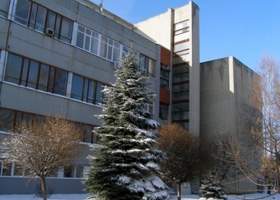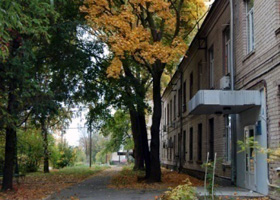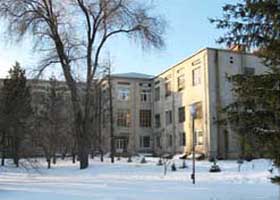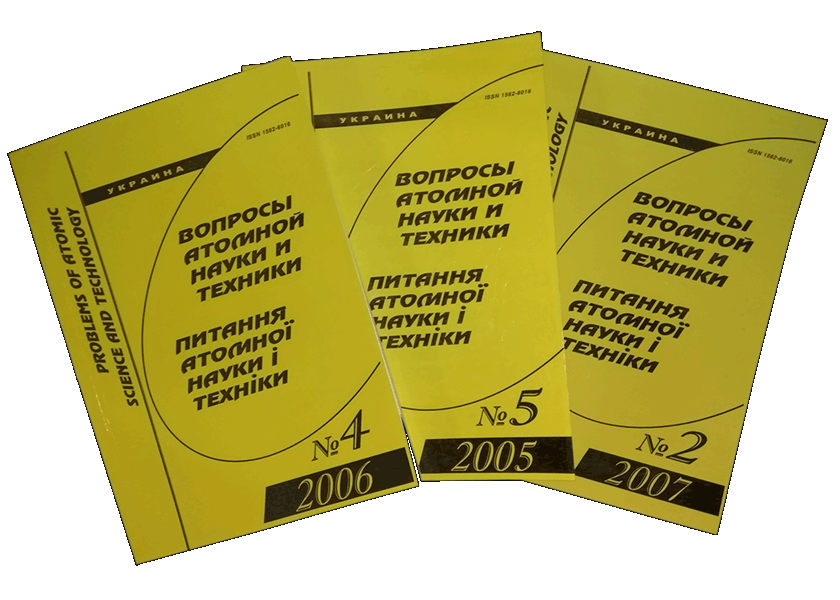


Main directions of research and topics
The Institute of Solid State Physics, Materials Science and Technologies (ISSPMT) is a member of NSC KIPT. The Institute is a multidisciplinary research center of materials science established in 1993 on the basis of the Department of Physical Materials Science of NSC KIPT.
The priority tasks of the Institute include the development of new materials and technologies in relation to the needs of nuclear, thermal, solar and hydrogen energy, space, aerospace and engineering industries, medicine. Among them there are:
– materials for the existing and prospective nuclear and thermonuclear reactors (including nanostructured, high-entropy, etc.);
– accident-tolerant nuclear fuel (ATFC);
– simulation studies of radiation behavior for the existing and promising materials of NPP cores, service life prediction;
– physical materials science of pure and ultrapure metals, development of technologies for their preparation, analysis and application;
– development of innovative processes, technologies and equipment to improve the performance of materials through their surface modification based on ion-plasma, plasma-chemical, activated diffusion processes using SHS;
– development of new materials and technologies for producing carbon and carbon-carbon materials for various industries;
– development of radiation-resistant ceramic materials for compaction, storage and disposal of radioactive waste;
– development of the methods for direct reduction of metals from ores and wastes of metallurgical industry on the basis of plasma-chemical processes;
– development and manufacture of the instruments and materials for medicine (implants, bactericidal coatings and treatments, soluble stents and implants, disinfecting dressings, etc.);
– development of the existing and innovative methods, technologies and equipment for controlling the properties and characteristics of materials and monitoring the environment.
Results of scientific and technological activities
The present-day ideas on the physical nature of radiation damage phenomena, ways to develop radiation-resistant materials meeting the highest requirements of the time (safety, efficiency, competitiveness, environmental friendliness) were created. The investigation was carried out at the atomic level using the appropriate instrumental base, modern methods, theories and modeling of radiation damage, as well as the advances in the traditional physics of metals including the progress in research and development of nanostructure-based materials.
New ideas on the physical mechanisms of the structural-phase transformations in multicomponent materials with FCC, BCC and HCP crystal lattices were developed. The characteristics of these mechanisms consider the interaction of primary radiation defects with the materials, processes of formation and evolution of the defect-structure components and solid solution decay under irradiation, evolution of coherent and incoherent boundaries for precipitates of other phases during irradiation.
At the moment, special attention is paid to the development and study of a new class of materials called oxide-dispersion-strengthened steels. These materials are promising in terms of high performance characteristics and radiation resistance. The swelling of ferritic-martensitic steels irradiated to ultrahigh doses (500 dpa) was studied. It was shown for the first time that the swelling of these steels after a long incubation period can reach tens of percent.
The principal features and microstructural mechanisms of radiation damage for a wide range of commercial and promising austenitic and ferritic steels were identified. The connection between these mechanisms and the processes of material degradation under irradiation was found.
The effect of sink strength on the swelling of oxide dispersion strengthened (ODS) austenitic steels under irradiation with heavy ions was determined for the first time. The addition of ZrO2 to the Y2O3 nano oxide for the manufacture of ODS steel leads to a significant decrease in the grain size and precipitation of secondary oxides. Also, the uniformity of oxide distribution over the sample is increased. The decrease in the grain size and precipitation of secondary oxides leads to the decrease in swelling by more than 5 times. The suppression of swelling can be explained by the increase in the recombination of point radiation defects at the sinks, which are the "nano-oxide matrix" interfaces and grain boundaries.
The results on determining the parameters of swelling in structural materials at ultrahigh levels (concentrations) of transmutant gases (helium and hydrogen) were obtained for the first time. It was found that the behavior of radiation swelling for the ferritic-martensitic steels depends on the concentration of helium and hydrogen, which have different effects on the kinetics and magnitude of swelling at different stages (in the incubation period and at the stationary stage). During the incubation period, helium increases the swelling due to the earlier nucleation of pores. At the stationary stage, helium reduces the swelling. This can be explained by the fact that at a high concentration of pores, their size is significantly reduced. Hydrogen also accelerates the start of swelling, but has lesser effect on the nucleation of pores; this can even lead to the increase in swelling at the stationary stage due to a moderate increase in the concentration of pores.
The correlation between the structure developing under irradiation and the level of hydrogen isotope accumulation was established for the first time. It was shown that the concept of using strong “useful” hydrogen traps capable of reliably retaining hydrogen throughout the entire service life of a nuclear object in the entire operating temperature range is of key importance to neutralize the harmful effect of hydrogen and increase the resistance of materials to hydrogen degradation in thermal radiation fields.
Thin-film (V, Ti, Mg) Nx–H2 structures capable of absorbing up to 7 wt.% hydrogen at the pressure of 0.3 MPa for 100 s were developed. Such gravimetric and kinetic characteristics meet the DOE requirements for solid-state hydrogen storage.
For the first time in the world practice, the evolution of structural-phase transformations in the metal for the main circulation pipeline (MCP) of WWER–1000 reactors was studied after 32 years of operation using the up-to-date direct methods. Signs of metal aging after a long-term operation were found: changes of the structure both in the average grain size and composition of granular and lamellar pearlite. The decrease in the average size of carbide precipitation and location of carbides at the grain boundaries was found. The results of monitoring the mechanical properties and impact toughness (without violating the integrity of MCP), along with the structural studies, made it possible to extend the life of MCP for the power unit No. 1 of the South Ukraine NPP until 2031. It was also proposed to modernize the existing procedures for zonal-periodic monitoring of heat exchange equipment for the WWER–1000 power reactor by improving the methods of temperature-dependent internal friction and magnetic memory of metals.
The technology for manufacturing the products with quasi-isotropic, hardened, fine-grained structure from zirconium-based alloys using the high-speed heat treatment was developed. No radiation growth was observed in the manufactured in-channel pipes and rods after irradiation to 8 × 1026 n/m2, and the creep significantly decreased.
New ideas on the structural changes in solids at the particle condensation under the influence of radiation, which significantly expand the capabilities of radiation, ion-beam and vacuum-arc technologies for the development of fundamentally new materials, improvement of wear resistance and corrosion resistance of tools and products were created.
Based on the study of the processes for interaction of electrons and photons with polymers, organic substances and biological samples, new technologies for radiation sterilization of medical equipment were developed in cooperation with the Institute of High Energy Physics and Nuclear Physics. Currently, new electrophysical technologies and equipment are being developed in the field of environmental protection and agricultural production.
A number of environmentally friendly low-temperature coating deposition technologies were developed. These technologies are introduced into the manufacture, including consumer goods (strengthening of cutting tools and machine parts, anti-corrosion and protective-decorative coatings, thick-layer self-supporting products, high-temperature protective coatings, etc.). To implement these technologies, special units, such as "BULAT", "AIR", "YANTAR", "POTOK", "BASALT" and others were designed and manufactured.
Complex physical methods for the manufacture of ultrapure metals were developed. These methods are based on electron beam melting, vacuum distillation, zone recrystallization and electrical transfer. Physical properties of these materials were studied.
Physical fundamentals for solving the problem of beryllium fragility were developed. A superplastic metal was obtained. An ultrathin vacuum-tight beryllium foil, long-length beryllium hyperconductors with a record-high electrical conductivity at 77 К and small-sized transformers were manufactured on the basis of these fundamentals.
Bimetals and layered composites, which consist of the layers of refractory, non-ferrous, rare-earth and other metals and alloys, were manufactured by hot rolling in vacuum. The high tensile strength at the interface between the layers of bimetals and laminated composites allows using various manufacturing processes (for example, heat treatment, machining, forging, pressing) to obtain shaped products.
Gas-phase methods and technologies for obtaining high-quality carbon materials were developed for manufacturing space technology products, fuel elements and absorbing elements of nuclear reactors, high-temperature heaters (up to 3000°С), thermal shields for melting and synthesis of other high-temperature materials; crucibles and foundry equipment for melting ferrous, non-ferrous and precious metals; transfer molds and dies for high-temperature pressing of metals, ceramics and diamond tools; electrodes, cages for thermal, galvanic, electrolysis and other industries; heat exchange fittings for operation in aggressive liquid and gaseous media; structural elements of nuclear reactors and thermonuclear units; brake discs and linings for cars; collector brushes for urban transport.
Highly effective barrier coatings for zirconium alloys were developed. These coatings prevent the contact of the coolant with the zirconium cladding and, as a consequence, the development of a vapor-zirconium reaction with the release of hydrogen as the temperature in the reactor is increased at the loss of coolant, both under operating and emergency conditions. Test results for the samples with fuel element coatings show high radiation, corrosion and cavitation resistance of protective layers, increased reliability of fuel elements under operating conditions, and in emergency conditions, the coatings are not destroyed at the temperature of 1100°С for at least 3600 s, which allows operating personnel to take emergency measures.
On the basis of the investigations for the diamond-like carbon coatings, the technology and equipment was developed, the in-line production was organized for the deposition of single and multi-layer diamond-like coatings with the hardness of up to 40 GPa on the ring elements made of silicon carbide for the dry gas seals (DGS) of compressor shafts in the gas transmission systems and for the chemical industry. The technology was successfully introduced into production.
Under the cooperation with the Argonne National Laboratory (USA), the manufacturing process for the phosphate ceramics KMgPO4 · 6H2O was developed for immobilization of radioactive waste. Complex testing of the obtained materials for strength, corrosion and radiation resistance was carried out and the positive results were obtained.
A laboratory process of fluorination was developed using the samples simulating the waste from the government enterprise “SkhidHZK” and production association “Pridneprovsky chemical plant”. It is shown that in the process of fluorination, at least 90% of silicon and tungsten is removed in the form of gaseous fluorides, due to which the total amount of solid waste is reduced by 60 – 65%. Radioactivity of the waste from these enterprises can be significantly reduced due to the release of uranium at the gas-fluoride treatment.
A nuclear-physical method was developed using a broadband X-ray filter for non-destructive determination of Hf with low concentration in the materials made of zirconium alloys using the proton beam released into the atmosphere.
Hf concentration was measured and the homogeneity of Hf distribution of in the Zr1% Nb ingots obtained by the electron-beam melting with electromagnetic stirring, without electromagnetic stirring and with centrifugal casting was determined. It was found that when using the first melting method, the ingot had a uniform Hf distribution with the concentration of less than 0.05% (normative document).
Achievement of the goals is ensured through the series of fundamental and applied research on a number of state programs of NAS of Ukraine:
Atomic science and technology, departmental topic (AST).
Departmental order of NAS of Ukraine for conducting scientific research in atomic science and technology of the National Science Center "Kharkiv Institute of Physics and Technology".
Nuclear and radiation technologies for the energy sector and community needs.
The targeted comprehensive program for the scientific research of NAS of Ukraine.
The "RESOURCE" program.
Problems of resource and safety in exploiting constructions, buildings and machineries.
Fundamental problems of nanostructured systems, nanomaterials and nanotechnology.
The targeted comprehensive program for the scientific research of NAS of Ukraine.
Nanotechnology and nanomaterials.
The state targeted science and technology program.
Competitive topic of NAS of Ukraine.
Innovative projects.
Science and technology support for the development of nuclear power industry and application of radiation technologies in the sectors of economy.
The target complex program on the scientific research of NAS of Ukraine.
Grants for young scientists and groups of scientists.
Joint projects with foreign partners.
Structure
The institute employs: 1 academician and 2 corresponding members of NAS of Ukraine, 30 Doctors of Sciences, more than 80 PhDs, more than 15% of the total number of employees of the Institute are young employees (under 35 years old).
The institute includes the following subdivisions:
– Pure Metals, Physics of Metals and Technology of New Materials.
The main directions of work are the development of high-purity metals and structural materials, including zirconium-based, high-entropy alloys, as well as reactor steels and alloys strengtened with nanosized oxides, high-energy magnets (based on iron and cobalt alloys); the investigation of materials with special electrophysical properties and beryllium purification mechanisms; the development of technologies and devices for deep refining of metals and their isotopes, devices based on semiconductor sensors (CdTe, CdZnTe and CVD diamond films) of gamma radiation.
– Ion-Plasma Treatment of Materials.
The main direction of work is anti-corrosion and anti-erosion protection of structural materials operating at high temperature loads (up to 2000°C); deposition of antifriction, protective, decorative, bactericidal and antireflection coatings; formation of products by the deposition of materials from the plasma or gas phase, as well as creation of a new class of materials in the form of films.
– Physics of Radiation Phenomena and Radiation Materials Science.
The main direction of work is the theoretical and practical investigation on the interaction of materials with fluxes of neutrons and charged particles, development of the principles for creating new materials in reactor engineering.
– Solid State Physics and Condensed Matter.
The main direction of work is the experimental and theoretical investigation on the properties and structure of structural and functional materials under the influence of temperature-force, radiation, magnetic and electric fields in order to use them in the development of new materials and technologies in nuclear power industry and other fields of technology.
– Carbon-Graphite Materials.
The development of carbon composite materials for the promising and existing nuclear power plants and the methods for the development of carbon materials with ceramic matrix; the development of materials and critical elements for the rocket and space technologies, friction and antifriction carbon materials and biocompatible carbon materials, implants and structures on their basis for the needs of medicine; the investigations for the development of new carbon sorbents, filter elements, batteries.
– Intensive Vacuum-Plasma Technologies.
The main tasks of the department include the development of technological processes for producing protective strengthening coatings to increase the service life of equipment pieces for TPP, NPP, space technologies and engineering industry, as well as the improvement of the coating deposition methods and surface modification through the use of combined technological processes and extension of the range of parameter values ensuring implementation of the process.
– Gas-Phase and Plasma-Chemical Processes.
Investigation for the gas-phase crystallization of metals, alloys and compounds based on them using thermal and plasma-chemical reduction of metal-containing compounds; preparation of corrosion-resistant, wear-resistant and heat-resistant coatings for engineering industry, chemical industry, rocketry, electronics, medicine; manufacture of products in the form of crucibles, pipelines, high-pressure vessels, heaters, equipment for high-temperature vacuum furnaces.
– Gasostatic and Plasma Technologies.
The main direction of work is the development of the methods for compaction and immobilization of radioactive waste for temporary storage and final disposal, as well as the materials research for the manufacture of high-strength and radiation-resistant ceramics for functional purposes.
– Analytical Research, Environment and Radiation Technologies.
In the department, analytical support is provided and the materials science, environmental and biomedical research is conducted on the basis of the experimental study for the interaction of ion beams, X-ray and gamma radiation with the materials, and the new equipment is developed.
The Institute also includes the Analytical Equipment Sharing Center (Director of the Center is the Corresponding Member of NAS of Ukraine V.N. Voevodin).
Organizational and pedagogical activity

– Printed editions
Annually, 2 – 3 issues of the journal "Problems of Atomic Science and Technology" (PAST) are published in the field of "Physics of radiation damage and radiation materials science" and "Vacuum, pure materials, superconductors".
– International conferences and schools of young scientists
In recent years, the international conferences on the topic "High-purity materials: preparation, applications, properties" have been regularly held.
2019
Young Scientists Conference on Material Science and Surface Engineering (MSSE 2019).
September 25 – 27, 2019Lviv, Ukraine.
Photo galleryV International Conference "High-purity materials: preparation, applications, properties" dedicated to the memory of Academician of NAS of Ukraine Vladimir Mikhailovich Azhazha.
September 10 – 13, 2019Kharkiv, Ukraine.
Photo galleryInternational Conference of young scientists and PhD students (IEF-2019).
May 21 – 24, 2019Uzhgorod, Ukraine.
2018
XIV International Science and Technology Conference of Young Scientists and Specialists "Problems of Modern Nuclear Energy".
November 14 – 16, 2018Kharkiv, Ukraine.
International Conference and School on Plasma Physics and Controlled Fusion.
October 10 – 13, 2018Kharkiv, Ukraine.
All-Ukrainian conference "Chemistry, physics and technology of surface".
May 23 – 24, 2018Kyiv, Ukraine.
2017
ХIII International Science and Technology Conference of Young Scientists and Specialists "Problems of Modern Nuclear Power Energy".
18 – 20 октября 2017 р.Kharkiv, Ukraine.
The conference was attended by 81 people, 65 reports were presented.
CONFERENCE ORGANIZERS:
–Ukrainian Nuclear Society.
–National Science Centre «Kharkiv Institute of Physics and Technology».
–V.N. Karazin Kharkiv National University.
Photo galleryIV International Conference "High-purity materials: preparation, applications, properties" dedicated to the memory of Academician of NAS of Ukraine Vladimir Mikhailovich Azhazha.
September 12 – 15, 2017Kharkiv, Ukraine.
The conference was attended by 92 people from Ukraine, Japan, Great Britain and Sweden.
CONFERENCE ORGANIZERS:
–The National Academy of Sciences of Ukraine.
–Department of Nuclear Physics and Energy.
–National Science Centre «Kharkiv Institute of Physics and Technology».
–V.N. Karazin Kharkiv National University.
Photo galleryXXV Open Science and Technology Conference of Young Sciences and Specialists of the Physics and Mechanics Institute named after G.V. Karpenko of NAS of Ukraine.
September 27 – 29, 2017Lviv, Ukraine.
Conference "Materials resistant to extreme conditions for future energy systems".
June 12 – 14, 2017Kyiv, Ukraine.
During the discussion of the participation of Ukrainian scientists in the Euratom 2018 program (WP 2018), proposals for joint work were received from representatives of the Euratom European Commission: Dr. Lorenzo Malerba, Dr. Jacek Gajewski, Helena Zatlkaeva (Helena Zatlkajova) x SCK CEN, NCBJ Poland, Slovakia, respectively.
Proposals included the possibility of using the equipment of these organizations and NSC KIPT for joint research, training and retraining of Ukrainian scientists in SCK CEN, NCBJ Poland, lecturing on radiation physics in these organizations by leading scientists of ISSPMT NSC KIPT.Photo gallery2016
ХII International Science and Technology Conference of Young Scientists and Specialists "Problems of Modern Nuclear Energy".
November, 16 – 18, 2016Kharkiv, Ukraine.
90 people took part in the conference.
CONFERENCE ORGANIZERS:
–Ukrainian Nuclear Society.
–Youth section of the Ukrainian Nuclear Society.
–National Science Centre «Kharkiv Institute of Physics and Technology».
–V.N. Karazin Kharkiv National University.
Photo galleryInternational Conference and School on Plasma Physics and Controlled Fusion.
September 12 – 15, 2016Kharkiv, Ukraine.
2015
International Conference "Modern materials and technologies"
October 21 – 23, 2015Kharkiv, Ukraine.
III International Conference "High-purity materials: preparation, applications, properties" dedicated to the memory of Academician of NAS of Ukraine Vladimir Mikhailovich Azhazha.
September 15 – 18, 2015Kharkiv, Ukraine.
The conference was attended by 103 representatives of research centers and enterprises.
Reports of 29 research organizations from Kharkiv, Kyiv, Dnipro, Dniprodzerzhynsk, Zaporizhia, Belgorod, Voronezh were presented.
Photo galleryXXIII International Scientific and Practical Conference “Innovative Ways to Solve Topical Problems of Basic Industries of Ecology, Energy and Resource Saving”.
June 1 – 5, 2015Kharkiv, Ukraine.
2014
55th International Conference "Actual Problems of Strength".
June 10 – 11, 2014Kharkiv, Ukraine.
More than 104 people took part in the conference.
CONFERENCE ORGANIZERS:
–The National Academy of Sciences of Ukraine.
–Interstate Coordinating Council for Physics of Strength and Plasticity of Materials.
–National Science Centre «Kharkiv Institute of Physics and Technology».
–B.I. Verkin Institute of Low Temperature Physics and Technology.
–V.N. Karazin Kharkiv National University.
–Scientific Council of the Russian Academy of Sciences in Condensed Matter Physics "Institute of Physics and Technology" named after A.F. Ioffe.
2013
II International Conference "High-purity materials: preparation, applications, properties" dedicated to the memory of Academician of NAS of Ukraine Vladimir Mikhailovich Azhazha.
September 17 – 20, 2013Stryy Saltiv, Ukraine.
More than 50 people took part in the conference.
Photo gallery2012
V Russian-Ukrainian seminar-meeting "Development of nuclear energy in Russia, Ukraine and Armenia as the factor of sustainable interstate cooperation".
October 9 – 12, 2012Sochi, Russia.
There were 56 participants in total, including Ukraine - 29, Russia - 24, Armenia - 3.
Photo galleryXX Anniversary International Conference on Physics of Radiation Phenomena and Radiation Materials Science.
September 10 – 15, 2012Alushta, Crimea, Ukraine.
144 scientists took part in the work, including 98 - Ukraine (74 from NSC KIPT), 32 - Russia, 14 - far abroad.
Photo gallery2011
International Scientific Conference "High-purity materials: preparation, applications, properties" dedicated to the 80th anniversary of the birth of Academician of NAS of Ukraine Vladimir Mikhailovich Azhazha.
November, 15 – 18, 2011Kharkiv, Ukraine.
More than 100 people took part in the conference.
Reports with the participation of representatives of 40 research organizations from the cities of Kharkiv, Kyiv, Dnipro, Dniprodzerzhynsk, Zaporizhia, Moscow, Nizhny Novgorod, Belgorod, Glazov, Perm, Tbilisi were presented.
Photo galleryIV Ukrainian-Russian Science and Technology Meeting-Seminar "Development of nuclear energy in Russia and Ukraine as the factor of sustainable interstate cooperation".
October 3 – 7, 2011Sevastopil, Crimea, Ukraine.
Number of participants: 31 - Ukraine, 23 - Russia.
–Prospects for cooperation between Ukraine and Russia in the field of nuclear energy.
–Lessons from Chernobyl and Fukushima.
Photo galleryInternational School of Young Scientists in Nuclear Physics and Energy.
June 6 – 12, 2011Alushta, Crimea, Ukraine.
A total of 101 people took part, including 28 lecturers, 52 participants from NSC KIPT, 15 - from other parts of Ukraine and 6 - from Russia.
Photo gallery51st International Conference "Actual Problems of Strength".
May 16 – 21, 2011 р.Kharkiv, Ukraine.
The conference was attended by 140 people from 6 countries; 80 participants are foreign guests.
Photo gallery2010
III Meeting-Seminar "Development of Nuclear Energy as the Factor of Sustainable International Cooperation".
October 19 – 21, 2010Vinogradovo, Moscow region, Russia.
Number of participants: 38 - Ukraine, 51 - Russia.
Organizations: 13 - Ukraine, 13 - Russia.
Photo galleryХIХ International Conference on Physics of Radiation Phenomena and Radiation Materials Science.
September 6 – 11, 2010Alushta, Crimea, Ukraine.
Number of participants - 171.
Participating countries - 8 (Ukraine, USA, Austria, Russia, Belarus, Georgia, Lithuania, Kazakhstan).
Organizations - 24.
Photo gallery2009
Science and Technology Meeting-Seminar "Development of nuclear energy in Russia and Ukraine as the factor of sustainable interstate cooperation".
October 19 – 23, 2009Energodar, Ukraine.
Photo galleryInternational School of Young Scientists in Nuclear Physics and Energy.
June 12 – 18, 2009Alushta, Crimea, Ukraine.
Photo gallery2006
International Conference "Condensed Matter Physics at Low Temperatures" dedicated to the 100th anniversary of the birth of Academician B.G. Lazarev.
June 20 – 22, 2006Kharkiv, Ukraine.
Photo gallery